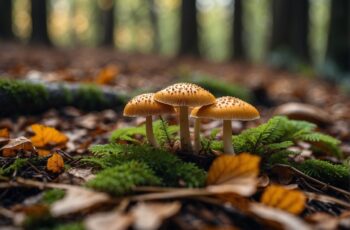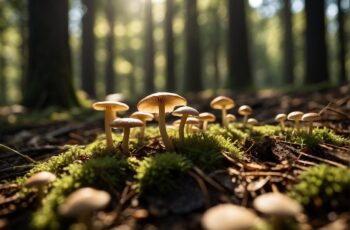Mushroom hunting in Western Massachusetts is an exciting and rewarding activity that blends a love of nature with the thrill of the hunt. The region’s diverse landscapes, from the rolling hills of the Berkshires to the lush forests scattered throughout the area, offer a fertile ground for a variety of fungal treasures. Whether you’re a seasoned mycophile or new to the world of foraging, the ample woodlands and the right conditions make Western MA a prime spot for discovering both common and rare mushrooms. To ensure a successful foray into mushroom hunting, familiarizing yourself with the local species, their habitats, and the best times to search is essential.
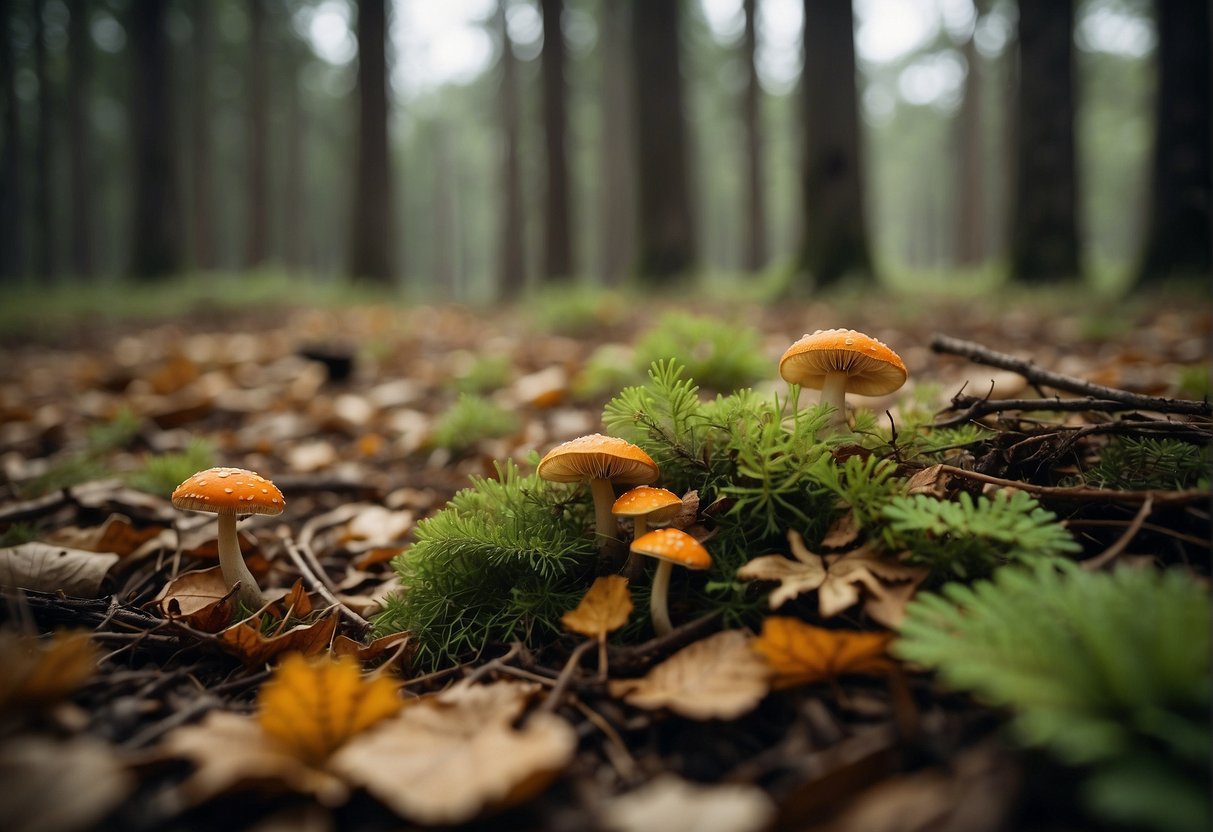
As you prepare to embark on your fungal quests, remember that safety and sustainability are paramount. Proper identification of mushrooms is crucial, as some species are toxic and can resemble edible varieties. Equipping yourself with knowledge from local foraging resources and events can significantly enhance your foraging experience, helping you to avoid any poisonous pitfalls. Additionally, understanding and practicing sustainable foraging methods ensures that the mushroom populations and their habitats remain undisturbed for future generations of foragers to enjoy.
Key Takeaways
- Mushroom hunting is a popular activity in Western MA due to its abundant and diverse fungal species.
- Correct identification and knowledge are crucial for a safe and successful foraging experience.
- Sustainable practices and local expertise are essential to preserve the natural environment for future mushroom hunters.
Getting Started with Mushroom Hunting
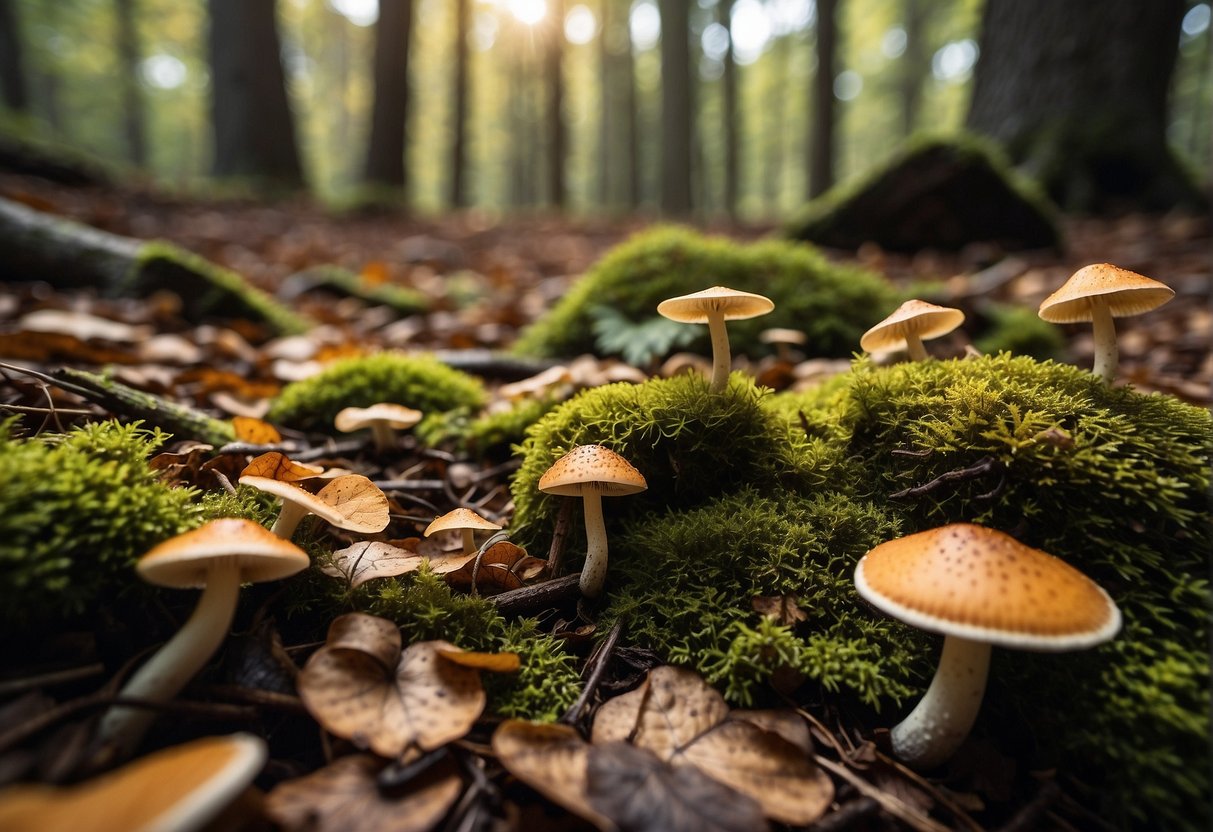
Before venturing into the woods for your first mushroom hunting experience in Western Massachusetts, it’s important to understand the specific seasons, have the right equipment, and be aware of safety and legal guidelines. Let’s dive into the essentials to ensure your foraging adventure is successful and enjoyable.
Understanding Mushroom Seasons
Edible Mushrooms: They have distinct seasons in Western Massachusetts. Morels, for instance, are often found in late spring, while chanterelles can be plentiful during the summer months. It’s crucial to know which mushrooms are in season to maximize your chances of a fruitful hunt.
- Spring: Morels, Oyster mushrooms
- Summer: Chanterelles, Boletes
- Fall: Hen of the woods, Lobster mushrooms
Knowing the seasonal patterns can guide you to the right times for different species.
Essential Equipment for Foraging
To be a successful mushroom hunter, you’ll need the right tools:
- Knife: A small knife to carefully cut the stem without damaging the mycelium.
- Basket or Mesh Bag: Allows spores to disperse as you continue your hunt.
- Field Guide: A trusted guide is indispensable for identifying species correctly.
- Compass/GPS: Maintain your bearings in the woods.
Remember, your equipment can enhance your foraging efficiency and impact how many mushrooms you’ll bring home.
Safety Guidelines and Legal Considerations
Safety First: Always hunt with a buddy, especially when you’re new to foraging. Never eat a mushroom unless you’re 100% certain of its identification; some look-alikes can be poisonous.
- Check the laws: Be aware of trespassing laws and obtain permission if foraging on private land.
- Respect nature: Forage sustainably by taking only what you plan to use and avoiding over-harvesting.
- Learn from locals: Joining a local mycological association can provide insight into the dos and don’ts in your area.
Abiding by local laws and adhering to ethical foraging practices is essential for the longevity of your mushroom hunting endeavors in the United States.
Identifying Edible Mushrooms in Western MA
Western Massachusetts is a fertile ground for mushroom foraging, especially if you’re looking for edibles like the famed morels. Knowing what to look for and how to distinguish them from non-edibles is crucial.
Characteristics of Morels and Other Edibles
Morels are particularly sought after in Western MA and can typically be found during the spring. These mushrooms have a distinctive honeycomb appearance on their cap. Look for them in deciduous forests, especially where there’s leaf litter and shaded areas. In addition to morels, you’re likely to come across other edible types such as the hen of the woods, which prefers to grow at the base of oak trees and has a ruffled appearance.
Other Edibles in Western MA:
- Chicken of the Woods: brightly colored with a shelf-like formation on the sides of trees
- Chanterelles: yellow to orange with a funnel shape and often found near mossy areas
- Oyster Mushrooms: grow in clusters on dead or dying hardwood trees and have a delicate, oyster-like cap
For successful identification, pay attention to the surrounding vegetation and the tree types, as many mushrooms have preferred hosts.
Common False and Toxic Look-Alikes
When mushroom foraging, it’s imperative to be aware of false and toxic look-alikes. Many edible mushrooms have doppelgängers that can cause illness or worse.
- False Morels: appear similar to true morels but differ in that they have a cap which is attached only at the top, creating a sort of ‘skirt.’ They’re often found in the same habitats as true morels.
- Jack O’Lantern Mushroom: often mistaken for chanterelles, these toxic mushrooms are bright orange and grow in dense clusters on wood.
- Destroying Angels: these deadly fungi have a classic mushroom shape with white gills and can be mistakenly gathered by the uninformed.
Key Identifiers for Safety:
- Cap Attachment: Check if the cap is freely hanging or attached directly to the stem.
- Spore Print: Take a spore print to see the color, which can help differentiate between edibles and toxic varieties.
- Scent: Many edible mushrooms have a distinctive smell, while poisonous ones may be odorless or have an unpleasant scent.
Before you head out with your basket, make sure you’re familiar with these characteristics. When in doubt, join a local foraging group or consult with a mycologist to ensure a safe and enjoyable experience.
Best Practices for Sustainable Foraging
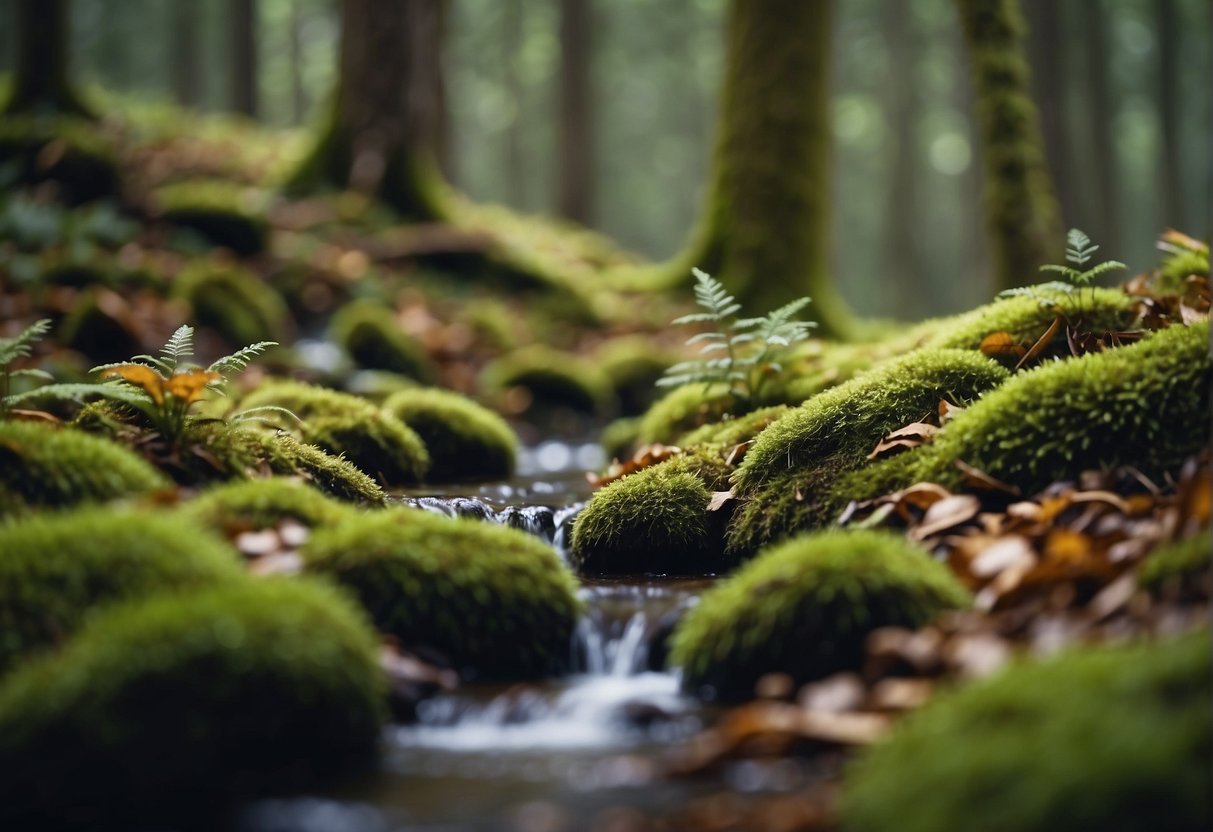
In Western Massachusetts, sustainable mushroom foraging ensures you enjoy the bounty of the forests without depleting their resources. By following specific guidelines, you can harvest mushrooms without harming the environment and foster their growth for future seasons.
Harvesting Without Harming
Foraging mushrooms requires careful consideration to protect the delicate ecosystems they belong to. When you’re in the woods, make sure to:
- Identify mushrooms accurately: Only pick species you are confident are edible and safe.
- Use a knife: Gently cut the stem instead of pulling the mushroom out. This minimizes damage to the mycelium.
- Leave the small ones: They need more time to grow and spread their spores.
You should also be mindful of the forests’ health. Stick to established trails to avoid trampling unknown plant or fungal species.
Fostering Mushroom Growth for Future Seasons
To ensure mushrooms can be enjoyed by future foragers, consider:
- Regulating your harvest: Take only what you need for personal use, and never clear a whole patch.
- Spreading spores: Before placing mushrooms in your basket, gently shake them to release spores back into the forest habitat where they can cultivate new growth.
Understanding local climate and temperatures is crucial. For instance, some mushrooms thrive in cooler temperatures; being aware of this can aid you in identifying the appropriate times for sustainable harvest. Respect nature’s cycle—what you do today can influence not just the next season, but many seasons to come.
Local Foraging Resources and Events
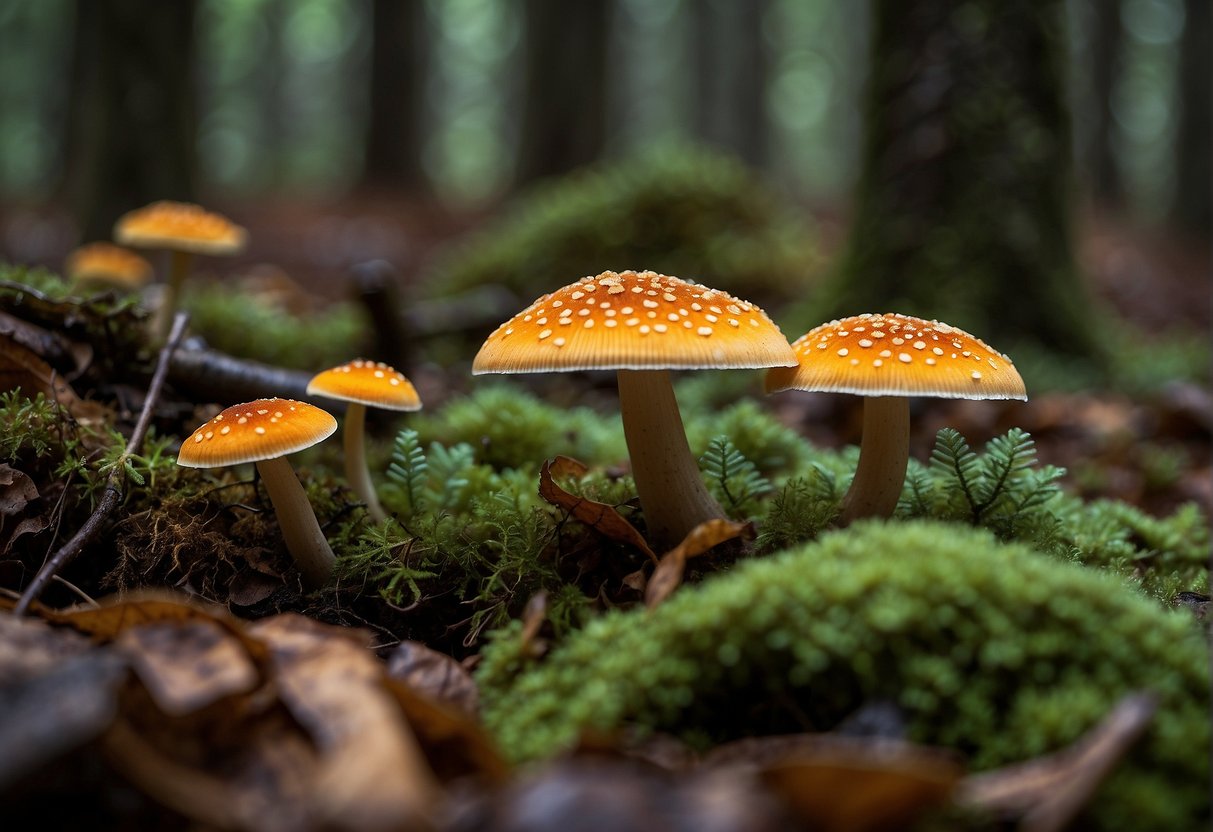
Dive into the world of mushroom hunting in Western MA with invaluable local resources and events tailored to both seasoned foragers and novices alike.
Joining Mushroom Clubs and Societies
Embark on a journey with fellow fungi enthusiasts by joining a mushroom club. The Pioneer Valley Mycological Association offers a robust platform for you to deepen your mycological knowledge through articles, newsletters, and participation in citizen science projects. Membership grants access to a community eager to share their expertise and the thrill of the hunt. You’ll uncover the hidden treasures of New England’s fungi through educational programming and sociable gatherings.
Upcoming Mushroom Foraging Tours and Walks
Get your boots ready for guided mushroom walks and foraging tours designed to enliven your outdoor adventures. Learn key identification skills with Mushroom Foraging in Western Massachusetts with Paul Lagreze, an opportunity to explore the fungal landscape with an experienced guide. Not only will you gain practical foraging insights, but you’ll also discover how to utilize mushroom maps and identify which fungi favor the diverse habitats of Western MA.
Check the Meetup page for the Massachusetts Mushroom Foragers for the latest schedule of events and consider planning your visit to local farmers markets where experts like Paul Lagreze often share their bounty and knowledge. Whether you’re someone who revels in the peacefulness of a solo hunt or prefers the camaraderie of a group walk, these resources will equip you with the skills you need to safely enjoy and harvest the mushrooms of Western Massachusetts.
Discover new flavors and reconnect with nature through these supportive learning experiences. And remember, websites like Eat The Planet are a treasure trove of information on foraging tours and events in the area, ensuring that your next outdoor quest is not only enjoyable but also safe and sustainable.

